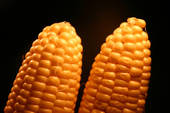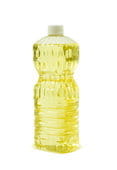“The Clean Foods Paradox”
fitter happier
(Cliff notes available at bottom of article)
As I mentioned in my first post, one of my personal prerequisites for starting a fitness blog is having something new to contribute. I also mentioned a bit of a background in nutrition research. For this post, I was to discuss what I call “The Clean Foods Paradox,” a paradox I picked up on while involved with my first research project.
The project involved having subjects follow the guidelines that many Paleo dieters follow (food choices were restricted to meat, fish, fruits, vegetables, eggs, and nuts, with no cereal grains, dairy, or legumes allowed). I will hold off on discussing the details of that project until our data finds a home in a peer-reviewed journal. I will, however, discuss the aforementioned “paradox” that I stumbled upon, since it does not divulge any details pertinent to our hypothesis or conclusions. If you really want a sneak peak at our data, come check out my poster at the ACSM Annual Meeting this year.
What is “Clean”?
Before going forward, let’s establish a working definition for “clean.” The term itself is rather ambiguous and open to interpretation, but we all know the foods that are commonly considered clean. They’re the bodybuilding staples: Brown rice, sweet potatoes, oats, chicken breast, fish, vegetables (especially broccoli and asparagus), and so on. They tend to be foods with high micronutrient density and relatively low energy density. The carbohydrate sources tend to be complex, low on the glycemic index (which I believe to be unnecessary), and high in fiber. Refined carbohydrates and simple sugars are largely avoided by “clean eaters.” Paleo takes this loose definition a step further, eliminating all dairy, cereal grains, and legumes.
The subjects in our study were exclusively consuming “Paleo-approved” foods, which tended to be packed with micronutrients. Virtually all sources of “empty” calories were off limits. This is where the paradox part comes into play. As I entered their dietary information into nutrition analysis software, I noticed a rather counterintuitive trend: These subjects, eating a diet almost exclusively composed of micronutrient-dense foods, were coming far short of the RDI for a number of micronutrients. How could this be?
Inclusion dieting vs. Exclusion Dieting
If you stop by any bodybuilding-related forum or Facebook group, a war is raging on: “Clean” dieting vs. IIFYM (If It Fits Your Macros). A quick Google search will reveal thousands of forum arguments on the topic, but I’ll summarize it for any outsiders who are unfamiliar. The old-school, “clean” dieters advocate strictly sticking with clean foods (particularly the bodybuilding staple foods listed above). The IIFYM crowd advocates a more flexible approach, allowing virtually any foods that fit within one’s target macronutrient intakes for the day.
I feel as if there are two ways to approach dieting— as you might have guessed from the bolded heading above, they are inclusion dieting and exclusion dieting. These approaches are characterized by distinctly different mindsets.
The inclusion dieter approaches food selection with the following mindset: “I will include food X in my diet, because it provides me with nutrients Y and Z.”
The exclusion dieter approaches food selection with a markedly different mindset: “I will exclude food X from my diet, because it hurts my dieting by providing Y and Z.”
(Note: One issue with the exclusion approach is its poor chances of long-term adherence. It forces you to decide that as long as you are dieting, you will avoid whatever “junk” foods you tend to crave (everybody has at least one— some, myself included, have several). As soon as you “break” and decide to satisfy that craving, you are officially off of your diet, which may cause you to take a long-term break from dieting, or may lower your confidence in your own ability to successfully diet in the future)
Bringing it all together
In my opinion, the Paleo diet, and diets focused on “clean” food sources in general, are inherently flawed. While there is certainly nothing wrong with the food sources they promote, their primary shortcoming is that they are predicated on exclusion dieting. Rather than selecting food choices that contribute the nutrients they need, these dieters focus more on avoiding things they perceive to be “bad.” The result is often superfluous intakes of some micronutrients, along with deficient intakes of others. This explains “The Clean Foods Paradox,” and why our subjects were eating micronutrient-dense foods all day and still falling short of recommended intakes for certain nutrients.
Having said that, I’m not letting the IIFYM crowd off the hook without some criticism. The idea was originally to allow some flexibility in the choice of food sources, giving the dieter the freedom to choose foods that fit their preferences for taste and convenience. This should increase the dieter’s self-efficacy, along with increasing the chances of long-term diet adherence. Unfortunately, it sometimes seems as if IIFYM has become a competition in which dieters try to fit as much ice cream and pop tarts into their diet as possible, often at the expense of fruits and vegetables (and the beneficial micronutrients and phytochemicals that come with them).
Conclusion
So what is the best way to diet? As is the case with most things in life, I believe moderation is key. When it comes to body composition, the most important factor of the diet (by far) is daily macronutrient intakes. My personal belief is that one should aim to satisfy their daily macronutrient targets (and their target for fiber intake) by choosing an overwhelming majority of micronutrient-dense foods, including plenty of fruits and vegetables. Although I take a multivitamin as a bit of “insurance,” I personally aim to achieve the RDI of all micronutrients from my whole food sources.
While the majority of foods should be nutrient-dense, I also believe there is nothing wrong with including other foods that would typically be considered “junk food,” as long as micronutrient needs are met and the foods fit within your macronutrient targets for the day. Incorporating such foods in this context will not disrupt your diet in any way, and taking such an approach provides a much higher chance for long-term diet adherence.
So the take home point is to set appropriate macronutrient targets and use whatever foods you want to hit those targets, as long as daily micronutrient and fiber needs are met. For most people, satisfying these micronutrient and fiber requirements will demand that the majority of food choices will be “cleaner” food sources by default. Once micronutrient and fiber needs are met, knock yourselves out with the elaborate (and very impressive) ice cream and pastry-laden concoctions. And share the recipe.
Cliff Notes:
• Eating “clean” or Paleo foods does not necessarily predispose someone to deficient micronutrient intakes. However, sticking to these micronutrient-dense foods does not automatically ensure adequate intakes of all micronutrients (i.e., you may have a surplus of some, with a deficiency in others).
• A very small percentage of IIFYM dieters do not focus enough attention on their micronutrient and fiber intakes. Although this is only a small percentage, I feel it is worth mentioning. The vast majority of well-informed IIFYMers are sure to hit their micronutrient and fiber targets every single day.
• All dieters, regardless of their “style” of dieting (Paleo, “Clean,” IIFYM, and so on), should be sure to hit their daily targets for macronutrients, micronutrients, and fiber. If you choose to hit these targets with only “clean” foods or Paleo foods, that is completely acceptable, but not entirely necessary.
• The promotion of inclusion dieting should encourage dieters to seek out foods that provide the nutrients they need, rather than demonizing certain foods or food groups. I believe this is a more psychologically healthy relationship with food, and it promotes more dietary flexibility while providing a greater chance for long-term adherence and success.
“The Clean Foods Paradox” Read More »

 Do you eat these harmful foods that AGE you faster? Some are even deceptively marketed to you as “healthy” by giant food corporations. Avoid or minimize these and look 5-10 years YOUNGER than your real age.
Do you eat these harmful foods that AGE you faster? Some are even deceptively marketed to you as “healthy” by giant food corporations. Avoid or minimize these and look 5-10 years YOUNGER than your real age. Food #1 that ages you faster: Wheat (yes, even “whole wheat”)
Food #1 that ages you faster: Wheat (yes, even “whole wheat”) Food #3 that ages you faster: Sugar, sugary foods, certain starchy foods
Food #3 that ages you faster: Sugar, sugary foods, certain starchy foods Food #4 that ages you faster: Soybean oil, canola oil, or other “vegetable oils”
Food #4 that ages you faster: Soybean oil, canola oil, or other “vegetable oils”